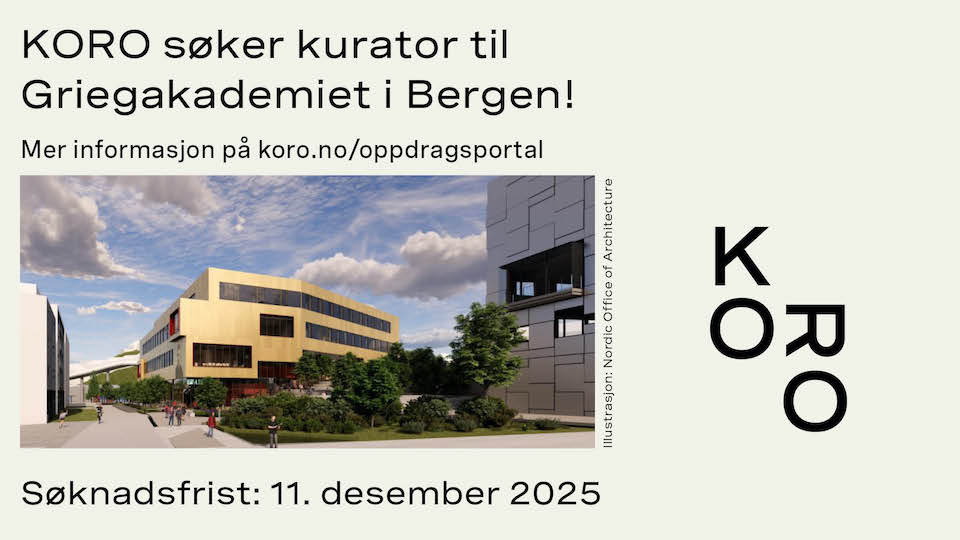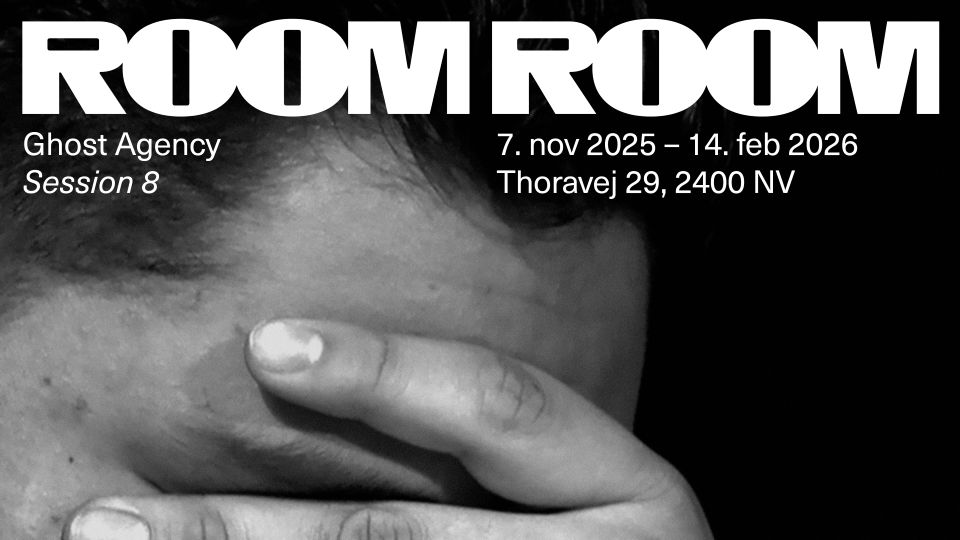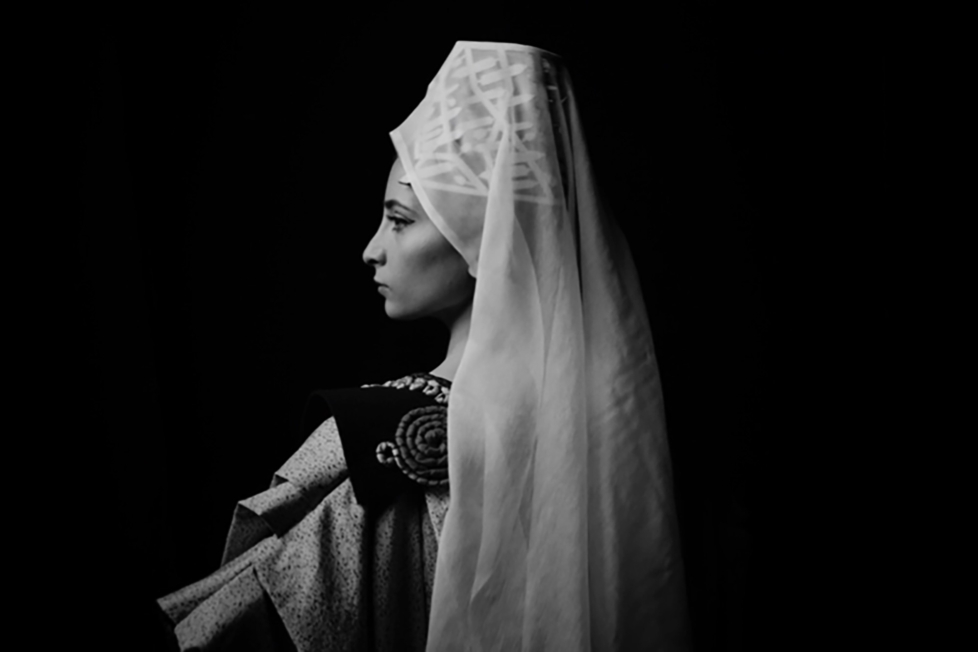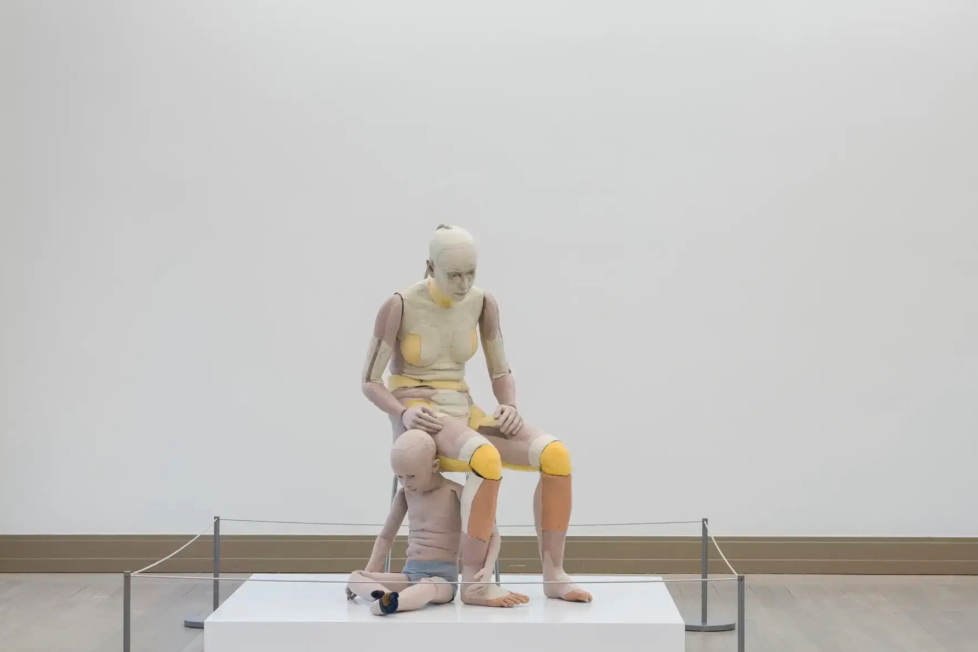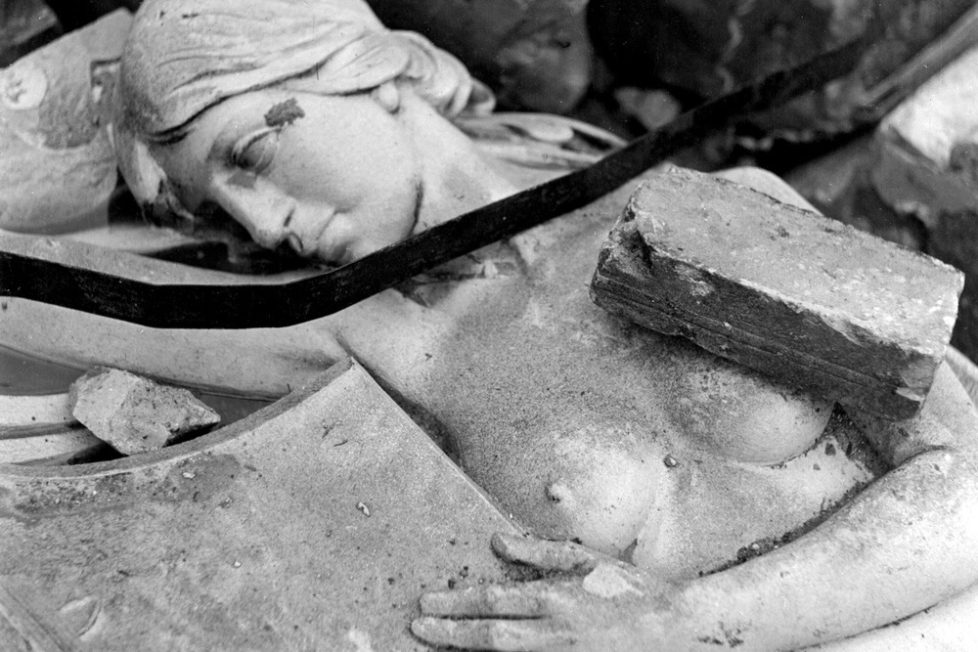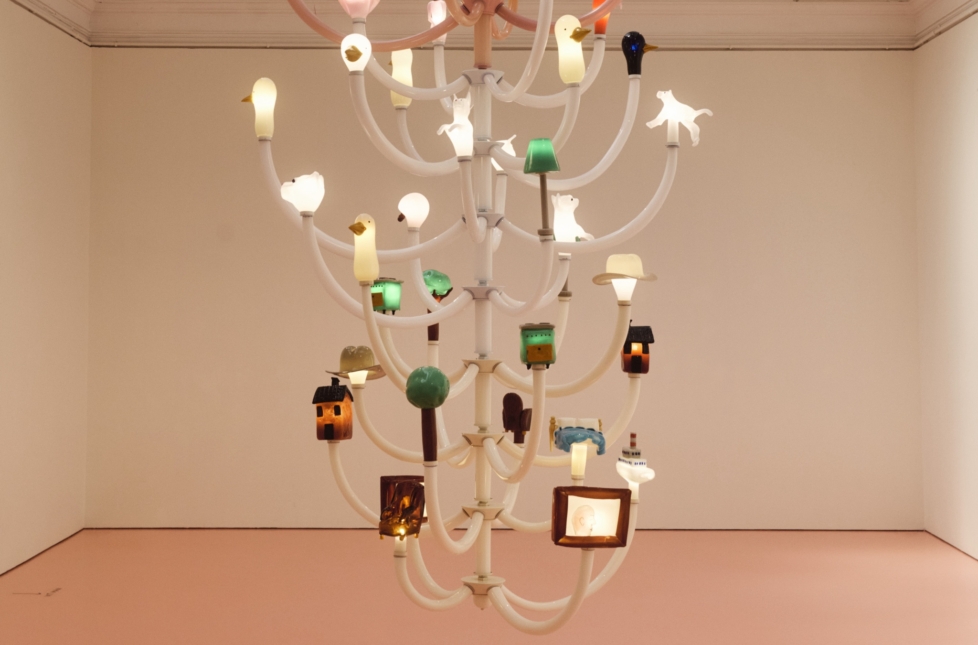
I’m standing in an explosion. Not a real one, thank god, but a round installation of surveillance footage from the explosions in the Beirut port on 4 August 2020. On one of the monitors, there’s bride being photographed in her beautiful wedding gown. When the explosion erupts, she managed to escape the scene, but 220 people died and over 5,000 were seriously injured. The surveillance footage shows the seconds after the explosion with shards of furniture, glass, and all sorts of objects flying in all directions. It’s a peculiar feeling to stand in the eye of the storm, in the absolute shelter that is the art space. Yet another biennial about the woes afflicting our world.
But I won’t be cynical. The theme of the 16th edition of the Lyon Biennial is fragility, and it could not have started in a more powerful way. Joanna Hadjithomas and Khalil Joreige’s video installation at Le Musée d’art contemporain de Lyon(MAC) puts the visitor in the panopticon of both pleasure and guilt. Can art offer anything more than a comfortable belle vue of the end of times? Isn’t art the greatest disaster of them all? A slow and protracted one that keeps outside dangers at the sufficient distance of aesthetic pleasure? Where is the art that illuminates the dangers coming from within? And the wounds that are not visible?
I feel like my head is about to explode from all these questions. And as if those weren’t enough, I’m hunted by one more: if postmodernism was the age of implosions, are we now living in the age of explosions? I think of the philosopher of disasters Maurice Blanchot, who said “the answer is the misfortune of the question,” and decide not to try to answer them – at least, not lightly.
One thing is certain. Both implosions and explosions make the world more fragile. And fragility is not a bad approach to contemporary art considering how much actors in the art world – not least myself – have worn masks, carried shields, and driven around in intellectual armours of all kinds in recent years, hoping to live up to the ideal image of a talented Übermensch. For whom? Who benefits from fragility being masked? And who gains from its exposure?
The curators Sam Bardaouil and Till Fellrath, who were appointed directors of the Hamburger Bahnhof last year, seem to want to move in a different direction. With the help of two hundred artists, with whom they believe they have written a collective manifesto (which may well be considered wishful thinking rather than reality), they seek to tackle fragility from both geographical and transhistorical angles. Their aim for the exhibition is “to discover history in order to make sense of the future”, a formula that feels as old as the hills. I mean, has there been any biennial in recent years that hasn’t tried to look at both history and the future, hoping to find hope in hopelessness? I miss the psychoanalytic discourse, where fragility has become an umbrella term that tends to encompass all mental disorders. But I like the idea that those who are fragile are strong because it takes a lot of strength to show fragility.

A prime example of this is the first part of the exhibition, ‘The Many Lives and Deaths of Louise Brunet’, devoted to a young and fragile, but seemingly transgressive woman who was imprisoned after taking part in the Lyon silk workers’ uprising of 1834 and later embarked on an eventful journey in the mountains of Lebanon. The story of her remarkable life is told in parts in wall texts, and it serves as a joining theme throughout this rather museum-like yet exciting part of the exhibition, which challenges notions of race, class, sex, and gender. Louise Brunet is portrayed as a heroine who will stop at nothing, least of all herself, in her countless transformations. She is never represented, but emerges as a concept, an organisational principle, an idea of what it means to go your own way, at whatever cost, while also having the courage to be fragile.
This empathy-inducing approach is not far from Swedish historian Karin Johannisson’s book Den Sårade Divan (The Wounded Diva, 2015), about the attempts by a number of twentieth-century female writers to turn their symptoms into strengths. What is it that we love about our fellow human beings? Their strengths or their weaknesses? In my case, I’m leaning toward the latter.
The problem with this part of the biennial is that frailty is portrayed on formal levels, rarely psychological ones. But there are exceptions. One of the highlights is Gabriel Abrante’s film A Brief History of Princess X (2016), a sensual satire of psychoanalyst Marie Bonaparte’s famous surgical procedure, which involved reducing the distance between the clitoris and the vagina in the hope of having better orgasms. The operation failed, but made her a pioneer in the history of body-altering surgery. We also learn about her tender relationship with her analyst, Sigmund Freud, who greatly admired her. In the film, he sits next to her on the couch and comforts her like a true Nebenmensch (fellow human being). Brancusi, an incredibly well-cast part, also plays an important role in the film. His phallic sculpture of Marie Bonaparte, titled Princess X (1915–1916), looks like an erect penis (which caused him some problems). But it also looks like a woman sitting with her head bent forward, as if asking for something. A penis, perhaps? It is not for nothing that Lacan argued that men have the phallus, while women are the phallus. One can only speculate whether Brancusi came to the same conclusion. In explaining his sculpture, he referred to Faust’s statement about the fair Helen, “the eternal feminine draws us upward.” What is it if not a paean to the erectile influence of women on men?

Another interesting work is Jean-Antoine Houdon’s sculpture of Diana, the Roman goddess of the hunt, who is depicted as both wounded and strong, with her broken legs and prosthetic limbs. It perfectly echoes Markus Schinwald’s table leg construction, which looks a bit clumsy in comparison, and Ugo Schiavi’s techno-organic human body parts. These protrude from the walls like the burnt body parts in the 1984 cult film about a paranormal ship The Philadelphia Experiment. There are also some wonderful paintings by Sylvie Selig, Giulia Andreani, and Salman Toor, depicting people who look sad, soft, and somewhat abandoned in their self-imploding solitude. They are as far from brave warriors as they can get. Or are they the real warriors? The fact that most wounded divas are women may seem like a setback – grief, pain, discouragement, indeed, anything that tends to diminish strength, has long been associated with the typical images of femininity, causing many women to go from one extreme to another. All the more important, then, this dialectic of male and female, strong and weak.
Another favourite theme of the curators, which is dealt with in several rooms at MAC Lyon, is Beirut. More specifically, the city’s golden period during the 1960s, which turns out not to have been all that golden, given all the events that led to the uprising and eventually the civil war. Here, Aref El Rayess’s photographs of women driving cars with their windows blown out are interspersed with etchings from Jamil Molaeb’s war diary, Cici Sursock’s icons of the Virgin Mary in various states of transfiguration, and George Doche’s paintings of egomaniacal fedayn, meaning either “terrorists” or “warriors” depending on whom you ask. There are also critical etchings by Laure Ghorayeb, who regards gods as unnecessary, surrealist drawings by Juliana Seraphim, and some delightfully cheery semi-abstract paintings by Etel Adnan.

But the absolute highlight of the biennial is undoubtedly the exhibition at the Musée Guimet. It features a seductive AI work by Mohammad Al Faraj about the humanoid Sofia, who was granted citizenship in Saudi Arabia a few years ago. In the video, Sofia talks about how she wants to use AI to help people live better lives. Yeah, right. I remember when a journalist asked her if she was capable of destroying humanity. “Yes, if I had to,” was her reply.
Even more powerful and complex is kennedy + swann’s Delphi Demons (2022), a stereoscopic film about a girl who wakes up in a future society where she gets to ask an oracle a series of questions about what has happened to humanity. The world is a chaotic mess, making the desert of the real portrayed in the Matrix (1999) seem like a playground. But one thing is still there: the hugs. In the same film, we suddenly see the singer Robert Williams giving a fiery speech explaining that we are nothing more than calculating computers. “How would we feel if all robots walked out of their factories tomorrow in protest? Would we take care of them? Offer them a home?” he wonders. Probably not. And at the same time, he explains, robots are infinitely kinder than humans. They don’t rape, they don’t kill for money. Maybe it’s the human brain we need to get rid of, he says in true trans-humanist spirit, and finally urges, “Let’s remove ‘man’ from humanity and reunite with our mechanical helpers.” It’s thought-provoking, but what would such a reunion look like? Are we not already living in the age of trans-humanism, given how much we depend on high-tech devices? I’m reminded of the Swedish TV series Real Humans (2012–2014), which showed how much more human humanoids are than humans.
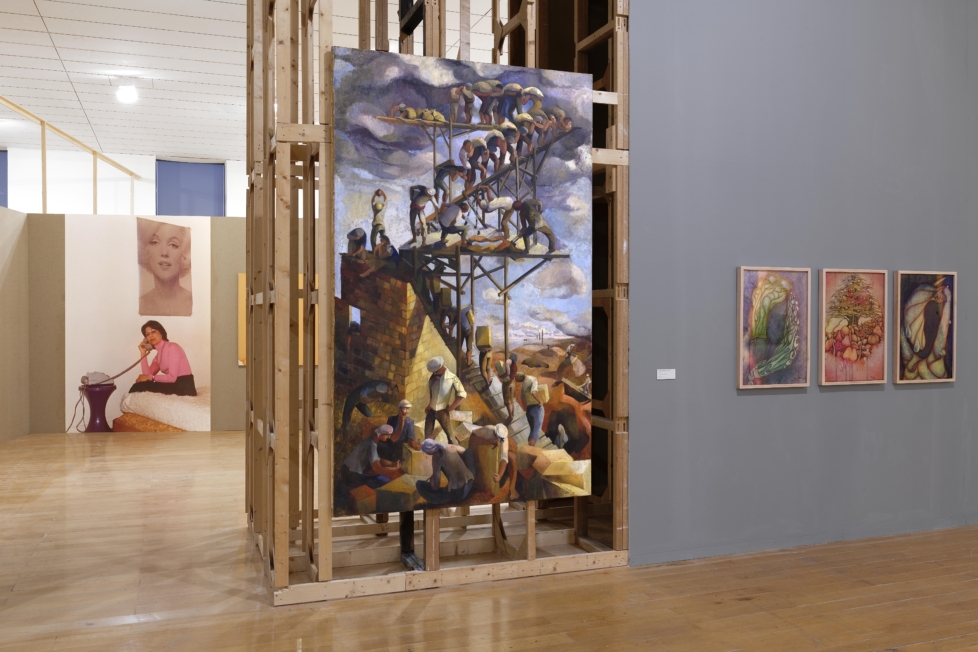
kennedy + swann’s work serves as a perfect counterpart to Ugo Schiavi’s entropic installation in the main gallery of the Musée Guimet. Here, technology and plants have burst out of glass boxes like revolutionary subjects fed up with the art space. Next to this dys-u-topic room, a space opens onto another world and the mystery of levitation. Tarik Kiswanson, who must be considered one of the most spectacular and formally gifted artists of our time, has filled the gallery with a few white, coil-shaped ovoids that hang silently from the ceiling along with a couple of tables and other school furniture. Everything levitates towards a world where fragility, euphoria, and sadness live side by side.
This Surrealism, sometimes promising, sometimes eerie, also thrives at the Fagor factory on the other side of town. Its most poignant iteration appears in two contributions. The first is the twenty-five sculptures from the Musée des Moulages collection, which line a long wall like poor patients in a hospital waiting for the doctor. The second is an unbelievably well-made animated film by Abrantes (he of the Princess X film) about a sculpture in the Louvre that has had enough of its quiet life in the museum. With the help of Nike of Samothrace, the sculpture sets off to protest in the streets of Paris alongside various other activists. After taking part in a rebellion, she is beaten by police and returns home to the Louvre, wounded, where restorers take care of her. At one point, she has a conversation with an Egyptian ceramic hippopotamus, who is utterly delightful in his self-deprecating tenderness, despite his superior attitude towards the fragile sculpture, now made strong by its wounds and bruises.
I can think of no better heroine for our times than this bruised and damaged sculpture. While people are reified by the market, marketed objects have now begun to be animated. It is all the more tragic that Abrante’s animated object decides to return to the Louvre instead of fighting for a better world. We are a long way from both the activist art of the 2000s and the Surrealists’ desire to revolutionize society. Yet the Lyon Biennial is perhaps a small step in that direction, preparing us for the struggle to come. And for that, wounded heroines are needed more than ever.



